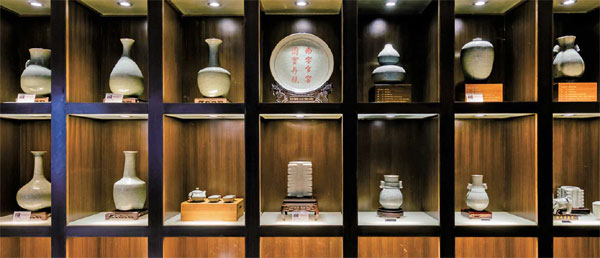Song so sweet
Updated: 2016-09-09 07:46
(China Daily Europe)
|
|||||||||
Discovery of dynasty's porcelain, famed for its aesthetics and technique, a boon for archeologists
Discoveries of Song Dynasty (960-1279) porcelain have been among the most exciting Chinese archeological finds in recent years.
Representing the peak of the ancient Chinese art, Song porcelain excelled in aesthetics and technique. Especially well known was celadon, or green ware (青瓷 qīngcí), meaning porcelain glazed in a transparent jade green.
|
Ye Guozhen's replicated porcelain artifacts from the Song Dynasty. Zheng Demeng / For China Daily |


Light green, gray or yellow glazed plates, vases and other vessels with simple and elegant style, exquisite Song ceramics were the dynasty's major exports at the time, traveling on the maritime Silk Road to Southeast Asia, the Indian subcontinent, Persia, Europe and Africa.
Recently, the wreck of the Nanhai 1
(南海一号 nánhǎi yīhào), a ship from the late Song period, was salvaged off the coast of Guangdong in 2007 and revealed more than 60,000 pieces of porcelain.
These pieces provide key insights into the ceramic industry and international trade at that time. Interestingly, some of it had been designed for a foreign market, featuring Arabic and other exotic styles that Chinese porcelain experts had not seen before.
Studies showed the pieces were all produced in private kilns in Fujian, Jiangxi, and Zhejiang provinces.
The porcelain made in the Song capital, now known as Kaifeng and in Henan province, was an even higher standard and only for the rich and powerful. References to two official kilns can be found in the historical records of Lin'an.
The relatively newer Altar of Heaven Kiln (郊坛下官窑 jiāo tán xià guānyáo) is easier to identify. It was excavated in the 1950s and can be found today at the Southern Song Dynasty Guan Kiln Museum (南宋官窑博物馆 nánsòng guānyáo bówùguǎn) in the eastern city of Hangzhou.
Reminiscent of Song architecture, the museum has an original kiln, an exhibition hall of uncovered ceramic treasures and a traditional workshop. Visitors can also meet with masters of the ancient skills.
The older kiln, known as Department of Palace Supply Kiln (修内司官窑 xiūnèisī guānyáo), is more mysterious. For decades, no one was able to locate it despite relatively detailed historical records. Some even claim it didn't exist.
It wasn't until 1996 that a kiln between the Phoenix and Jiuhua hills was excavated. This was the Tiger Cave Kiln (老虎洞窑 lǎohǔdòng yáo).
Here, archaeologists discovered shards of powdered blue and crackled glaze that they believe were made for the royal family and high officials. These pieces can also be seen at the Southern Song Dynasty Guan Kiln Museum.
It's not just archeologists who are interested. Modern collectors are obsessed with Song kilns, tripping over one another for a chance to acquire wares from the five famous kilns.
Courtesy of The World of Chinese, www.theworldofchinese.com
The World of Chinese
Rebirth of the Song kiln
The techniques for making porcelain in a Song Dynasty (960-1279) guan kiln were once thought lost. But after four decades of research, Ye Guozhen has brought back many of the ancient methods.
The key ingredient, he says, is the purple soil rich in iron that can be found around the original kiln sites. He has developed a method that involves skillful molding and carefully controlled temperatures - capable of replicating the high aesthetic values of Song kiln porcelain.
The Zhejiang provincial government has recognized his technique as intangible cultural heritage.

(China Daily European Weekly 09/09/2016 page23)
Today's Top News
No 'running commentary' on Brexit negotiations: PM
Girl earns $64,100 helping Chinese name their babies
Apple unveils iPhone 7, Pokemon Go coming to watch
Next step:Global action on growth
Greenland starts on UK's tallest residential building
Chinese women find their way through glass ceiling
China, UK vow to push 'golden-era' ties forward
MPs to debate second Brexit referendum petition
Hot Topics
Lunar probe , China growth forecasts, Emission rules get tougher, China seen through 'colored lens', International board,
Editor's Picks

|

|

|

|

|

|








